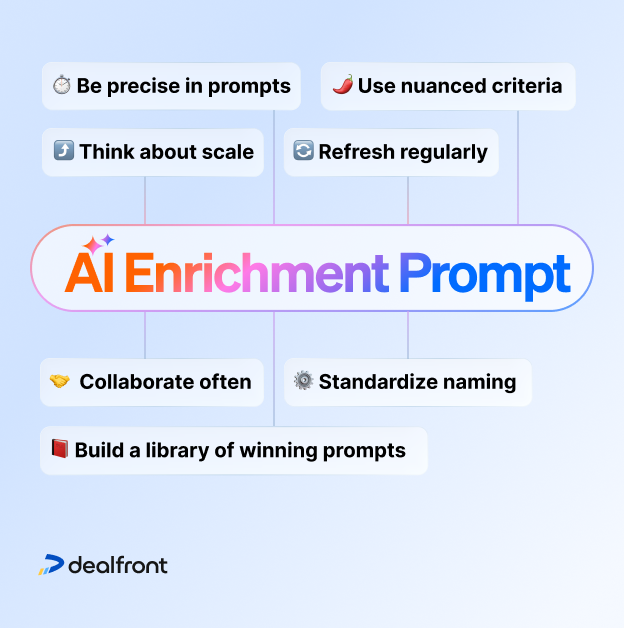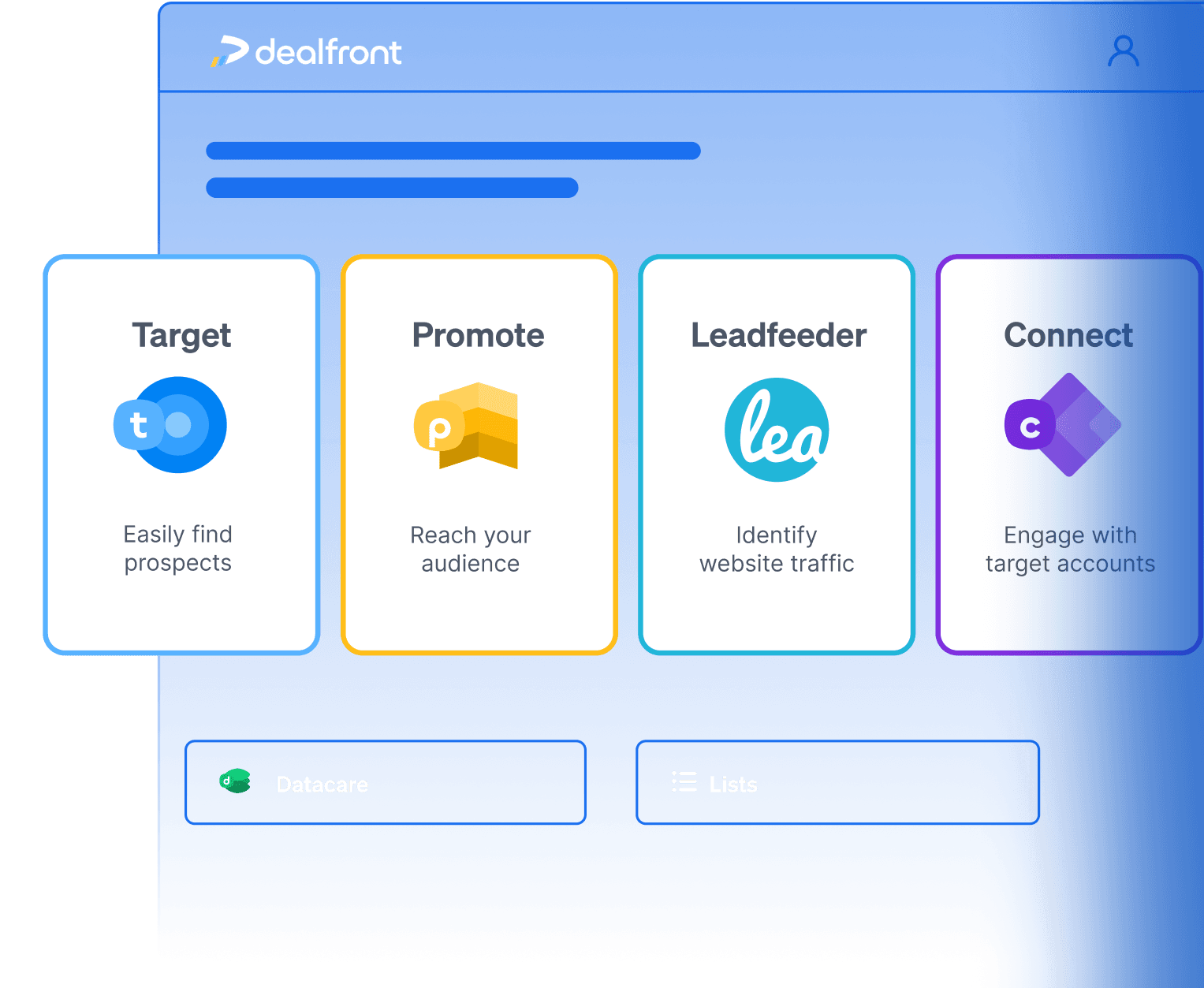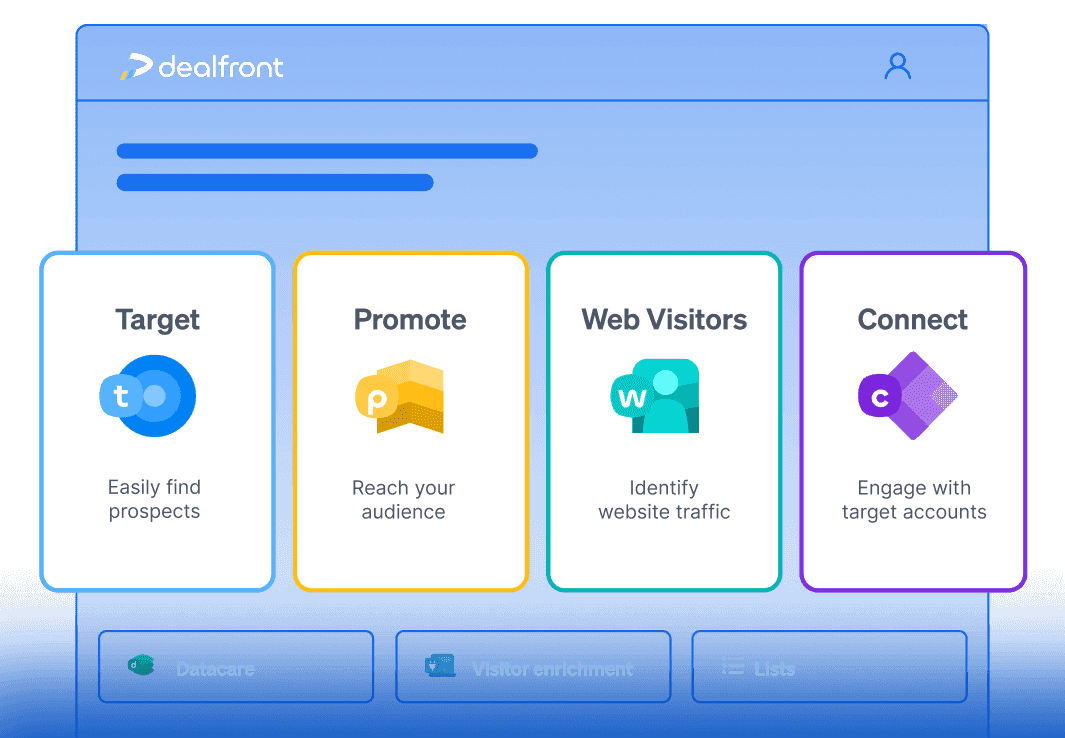How to Prioritize Your Outreach Without Spending Hours on Research
This play is also available in German.
Expected results
Automatically enriched lists with clear scoring, ensuring alignment between sales and marketing.
Faster prospecting and campaign targeting by focusing only on the most relevant companies.
Greater efficiency at scale, with large account lists prioritized in minutes.

When building campaigns or planning outreach, the hardest part isn’t collecting company names, it’s deciding which ones actually deserve your time and resources.
Marketing teams often face overstuffed target lists that dilute campaign precision and drain budget. Sales teams waste hours manually researching, scoring, and chasing accounts that never convert, leading to missed opportunities, slower pipeline progression, and frustration on both sides.
Dealfront’s AI Enrichment solves this problem. Using simple, natural language prompts, it automatically scores and qualifies company lists, so marketing targets only the best-fit accounts and sales focuses outreach on the most promising opportunities.
With AI Enrichment, you can:
Automatically prioritize large company lists in minutes, not hours.
Score and sort companies based on your custom criteria, from firmographics to buying signals.
Qualify leads with nuance, factoring in growth signals, company values, or strategic initiatives.
The problem with manual prioritization
For most marketing teams, the challenge isn’t collecting names for a target list, it’s making sure the right ones are at the top of that list. Campaigns that cast the net too wide inevitably end up wasting budget, because low-fit accounts absorb impressions, ad spend, and resources without ever converting. The result is often bloated campaigns that look impressive on the surface but lack precision where it matters most.
Sales teams face a different, but equally draining, version of the same problem. Reps often spend hours digging through company websites, LinkedIn profiles, and databases to manually score and prioritize accounts. This process is slow, inconsistent, and open to bias; what one rep considers a high-potential lead, another might dismiss. The time lost to manual qualification is time not spent on actual conversations with customers.
Together, these challenges create a shared bottleneck. Without a scalable, repeatable way to prioritize accounts, both sales and marketing end up working harder but not necessarily smarter. Teams chase the wrong companies, pipelines clog with low-quality leads, and meanwhile, genuine opportunities slip through the cracks unnoticed.
The Dealfront advantage: AI Enrichment
Dealfront’s AI Enrichment removes the guesswork and inefficiency from account prioritization by giving revenue teams an intelligent, automated way to focus only on the accounts that matter most. Instead of wrestling with formulas, pivot tables, or complex scoring models, teams can now rely on natural language prompts. Just describe the kind of companies you want to prioritize, whether that’s “mid-sized European SaaS companies with strong growth signals” or “North American manufacturers investing in automation”, and the system will take care of the rest.
Each account on your list is automatically scored and sorted, with transparent reasoning included so both teams can understand why certain companies rise to the top. This not only creates trust in the output but also builds alignment between marketing and sales, since everyone is working from the same set of criteria. Once enriched, the list is immediately actionable: campaigns can be activated around high-fit accounts, and reps can jump straight into outreach with the most promising prospects first.
Flexibility is also built in, meaning that as business priorities shift (whether that’s targeting a new vertical, launching a campaign in a new region, or adjusting territory focus) AI Enrichment adapts with you. Simply edit the prompt and re-run the enrichment. You can refresh the entire list, or just apply the enrichment to newly added companies, ensuring your prioritization process always stays current and relevant.
For marketing, this means leaner, smarter account-based campaigns that stretch budgets further by focusing only on the right companies. For sales, it means hours saved every week and a clearer sense of where to direct energy. Instead of slogging through manual research, reps can spend more time having meaningful conversations with prospects that are actually worth pursuing.
Step-by-step workflow
To make things even clearer, we’ve included a short demo from a recent webinar. In the clip below, Sjoerd walks through the full AI Enrichment process step by step, showing exactly how to go from a raw company list to a prioritized, scored set of accounts ready for action.
By watching the video, you’ll see how each stage works in practice: launching AI Enrichment, writing effective prompts, previewing results, saving scores, and updating enrichments as your priorities evolve.

Step 1 – Open your company list and launch AI Enrichment
The process begins inside the Companies List app in Dealfront. Once you’ve opened your target list, you’ll see the AI Enrichment option at the top of the page. This is the starting point for transforming a raw list of companies into an actionable, prioritized resource.
For marketing teams, this step is often used with imported campaign lists. Instead of working with an overwhelming list of accounts, AI Enrichment helps refine it with improved lead scoring and prioritization within the ICP segment.
For sales teams, this step allows you to take prospecting lists, which might otherwise require hours of research, and quickly identify which companies should be contacted first.
Step 2 – Write a natural language prompt
Next, you’ll define your criteria for prioritization using a natural language prompt. Instead of complex filters or formulas, you can simply describe the type of company you want to prioritize in plain English. For example: “European SaaS companies with over 200 employees that are growing quickly.”
For marketing, prompts can be written to align directly with ICP or campaign criteria, such as verticals, company size, or strategic focus areas.
For sales, prompts can be tailored to surface companies that show buying signals, operate in a rep’s assigned territory, or match patterns seen in recent successful deals.
The more precise your prompt, the stronger and more accurate the results will be.
Step 3 – Preview the results
Once the prompt is submitted, you can generate a preview of the enriched list. Each company receives a score from 0–10, with supporting reasoning visible when you hover over the score. This step provides immediate transparency into how and why the AI is prioritizing accounts.
For marketing, this preview is the opportunity to check whether the top-ranked companies truly align with campaign definitions and ABM target criteria.
For sales, it’s a chance to validate that the highest scorers reflect realistic opportunities that you’d actually want to pursue.
By reviewing before finalizing, both teams can confirm that the enrichment is producing meaningful results.
Step 4 – Define the output field
To make the scores actionable and reusable, you’ll need to decide where they should appear in your List table view. The scores are stored directly in the list as a column, you can choose where this column is placed for easier visibility and alignment with your existing data. Once set up, the field can be leveraged across campaigns, CRM workflows, and sales dashboards.
Marketing teams can use this field to build highly segmented campaign audiences or apply more precise filters in account-based marketing.
Sales teams can rely on the score within their CRM or prospecting tools to prioritize daily outreach and pipeline activities.
Step 5 – Save and run the enrichment
After configuring the output, the enrichment can be saved and run in full. Within minutes, your company list will be enriched with scores and automatically sorted so that the highest-priority companies rise to the top. This turns a previously unstructured list into a clear action plan.
For marketing, enriched lists can immediately feed into campaign activation, ensuring budget is directed only towards high-value accounts.
For sales, reps can begin outreach with confidence, focusing first on the accounts most likely to convert.
Step 6 – Review and take action
Once the enrichment has finished running, refresh your list and review the top results in detail. The combination of scores and reasoning allows you to not only see who the best-fit companies are, but also understand why they were prioritized. This transparency ensures that marketing and sales both trust the output.
From here, enriched lists can serve as the foundation for two distinct but connected activities:
Marketing teams can launch campaigns and ABM programs with smaller, smarter audiences.
Sales teams can use the prioritized accounts to structure daily prospecting, email outreach, and call lists.
Step 7 – Manage and update enrichments
Finally, enrichment is not a one-time activity; business priorities, territories, and campaign goals shift regularly, and your prioritization criteria need to evolve with them. Dealfront allows you to edit prompts at any time and re-run enrichments, either across the entire list or just for new companies added later.
Marketing teams can adjust prompts as campaign themes evolve, ensuring new content and targeting strategies stay aligned with ICP.
Sales teams can re-run enrichments as new prospects are added, keeping call lists fresh and accurate.
This ongoing flexibility ensures that enrichment remains a living, adaptive process rather than a static exercise.
Best practices & tips
To get the most value from AI Enrichment, both sales and marketing need to treat it as a shared process, not just a tool. The most effective teams align on how prompts are written, how scores are stored, and how enriched lists are reviewed. When these elements are standardized, everyone speaks the same language and trusts the same data. That alignment is what transforms enrichment from a tactical shortcut into a strategic advantage.

- 1.
Be precise in prompts – AI will only be as accurate as the instructions you provide, so avoid vague criteria such as “large companies” or “fast-growing firms.” Instead, define what those terms mean in your context. For example, specify headcount ranges, revenue thresholds, or types of growth signals that matter most to your business. The clearer your definitions, the more consistently the AI will identify accounts that really match your ICP.
- 2.
Think about scale – manual scoring may work for small lists of twenty or thirty accounts, but it becomes impractical when you’re dealing with hundreds or thousands. AI Enrichment is designed for these larger volumes, where consistency and efficiency matter most. By applying enrichment at scale, you free up valuable time while also ensuring that every account is measured against the same standards.
- 3.
Use nuanced criteria – too often, companies qualify accounts only on simple attributes like size or industry. While these are useful, they rarely tell the full story. By incorporating additional factors, such as whether a company is hiring aggressively, investing in certain technologies, or promoting specific values, you create a more sophisticated view of fit. This allows both marketing and sales to focus on accounts that not only look right on paper, but are also likely to engage.
- 4.
Standardize naming – consistency in naming conventions is another practical step that pays dividends. By agreeing on field names (for example, always calling the output “AI Fit Score”), you reduce confusion and ensure that everyone interprets the data in the same way. This may seem minor, but it avoids costly misalignment when marketing and sales teams are working with the same enriched lists inside different tools or systems.
- 5.
Collaborate often – it’s not enough for marketing to enrich lists on their own or for sales to rely on scores in isolation. You should schedule regular reviews of enriched lists together, discussing which companies scored highest and why. This creates an opportunity to fine-tune prompts, share AI insights, and build mutual confidence in the results.
- 6.
Refresh regularly – enrichment should be treated as a living process, not a one-off exercise. As campaigns shift focus or as new companies are added to prospect lists, rerunning enrichment keeps your priorities fresh. By regularly refreshing your lists, you ensure that sales reps are always working from the most up-to-date information, and marketing campaigns are targeting accounts that reflect current strategy rather than outdated assumptions.
- 7.
Build a library of winning prompts – over time, teams will discover which criteria consistently surface the best-fit accounts. By recording these prompts and making them accessible across both sales and marketing, you create a shared playbook that speeds up future work and reduces duplication of effort. This simple practice helps both teams get better results from AI Enrichment while building a culture of continuous improvement.
Expected results: what you’ll achieve with AI Enrichment
When marketing and sales adopt AI Enrichment as part of their workflow, the first benefit they notice is the time they get back. Hours previously spent researching accounts, cleaning lists, or debating which companies are worth targeting can now be redirected toward higher-value activities. Instead of burning energy on manual qualification, teams can focus on strategy, creativity, and direct customer conversations.
Time savings include:
Automating company scoring for both campaign lists and prospect lists.
Freeing up sales reps from repetitive research so they can spend more time in front of customers.
Allowing marketers to spend less time trimming lists and more time refining messaging and campaign design.
Just as important as saving time is ensuring that the time invested is spent on the right accounts. AI Enrichment provides a level of focus and clarity that manual processes struggle to match. By consistently identifying best-fit accounts, it reduces wasted effort and helps both teams channel their energy into opportunities that are more likely to pay off.
With better focus, you can expect to:
Build campaign audiences that contain only the most relevant companies.
Ensure sales reps concentrate their outreach on accounts with the highest likelihood to convert.
Reduce wasted spend in marketing while increasing conversion rates in sales.
Finally, AI Enrichment provides the confidence to operate at scale without losing precision. Whether you are enriching a list of fifty companies or fifty thousand, the same consistent scoring framework applies. This ensures that sales and marketing stay aligned, even as priorities shift or volumes grow. With shared definitions of what “best fit” means, there’s less room for misinterpretation and more room for coordinated execution.
Scalable impact looks like:
Handling even the largest account lists without extra manual effort.
Maintaining consistency in how “fit” is defined across both teams.
Growing campaign reach and sales coverage without compromising on quality.
The combined effect of these results is greater efficiency, stronger alignment between sales and marketing, and a higher return on the time and resources invested in go-to-market activity. In short: AI Enrichment helps your teams work faster, focus smarter, and scale with confidence.
Steal our free templates: AI Enrichment prompt examples
Writing effective prompts is often the difference between a good enrichment and a great one. Many teams start too broad or vague, which leads to results that feel generic. The real power of AI Enrichment comes when prompts are specific, grounded in your ICP, and reflective of the signals you actually care about. By collecting examples that work well, your sales and marketing teams can build a shared library of prompts that speeds up future enrichments and creates consistency across campaigns and territories.
Below are some ready-to-use examples that you can adapt for your own business. These are designed to help you get started quickly and to show the range of possibilities, from marketing campaign design to sales prioritization and cross-team alignment.
Marketing-focused prompts:
“Prioritize healthcare companies in North America with more than 200 employees that are actively investing in digital transformation.”
“Highlight mid-market SaaS companies in Europe with strong hiring growth in product and engineering roles.”
“Score higher any B2B technology firms in the UK that are expanding into AI or automation.”
“Identify consumer goods companies with over €50M in revenue that are publicly committed to sustainability initiatives.”
These types of prompts help marketing teams build sharper target lists for ABM or campaign activation, ensuring budgets are directed only at companies that fit the desired profile.
Sales-focused prompts:
“Highlight German manufacturing companies with 50–500 employees that have recently visited our pricing page or downloaded a product brochure.”
“Prioritize financial services firms in France with 1,000+ employees that are opening new regional offices.”
“Score higher US-based e-commerce businesses that are hiring for digital marketing and logistics roles.”
“Surface top prospects in the Nordics operating in logistics or supply chain that recently raised Series B funding.”
Sales teams can use prompts like these to uncover warm, high-potential opportunities faster and focus their energy on companies with stronger buying signals.
Joint sales and marketing prompts:
“Score companies higher if they are mid-sized SaaS firms in Europe expanding into AI or automation.”
“Prioritize firms in the renewable energy sector with more than 300 employees and clear international expansion plans.”
“Highlight North American retail brands that are opening 10+ new stores in the next 12 months.”
“Identify companies across EMEA that fit our ICP and have recently received Series C or later-stage funding.”
Joint prompts are especially useful for alignment, because they bridge both campaign targeting and sales outreach, ensuring both teams focus on the same kinds of opportunities.
When used together, these prompts can form the basis of a shared enrichment playbook. By saving and refining them over time, you can create a library of “winning prompts” that can be reused across campaigns, territories, and product lines. Not only does this save time, but it also ensures a consistent definition of what “best fit” looks like in practice.
Turn insights into action
Ready to grow your pipeline?
GDPR Compliant
Built & Hosted in EU
Deep B2B Data







